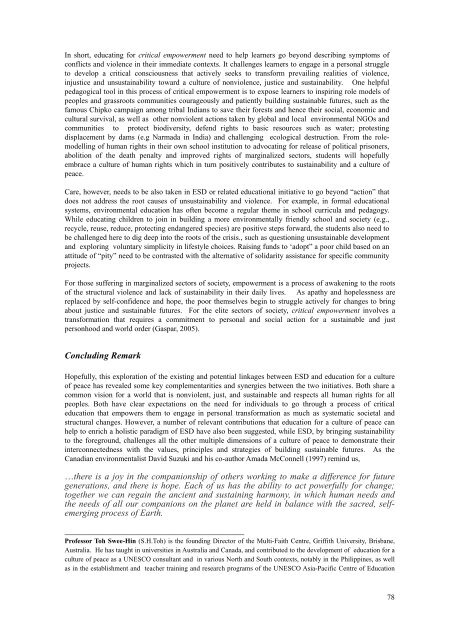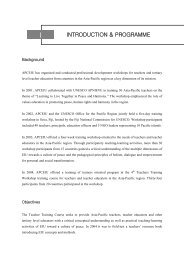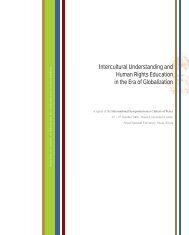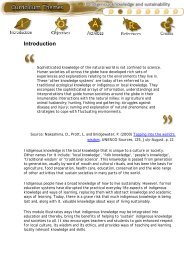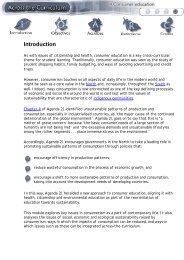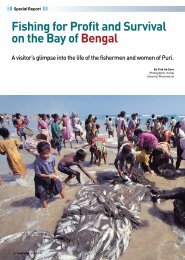REPORT OF UNESCO EXPERT MEETING ON - APCEIU
REPORT OF UNESCO EXPERT MEETING ON - APCEIU
REPORT OF UNESCO EXPERT MEETING ON - APCEIU
Create successful ePaper yourself
Turn your PDF publications into a flip-book with our unique Google optimized e-Paper software.
In short, educating for critical empowerment need to help learners go beyond describing symptoms of<br />
conflicts and violence in their immediate contexts. It challenges learners to engage in a personal struggle<br />
to develop a critical consciousness that actively seeks to transform prevailing realities of violence,<br />
injustice and unsustainability toward a culture of nonviolence, justice and sustainability. One helpful<br />
pedagogical tool in this process of critical empowerment is to expose learners to inspiring role models of<br />
peoples and grassroots communities courageously and patiently building sustainable futures, such as the<br />
famous Chipko campaign among tribal Indians to save their forests and hence their social, economic and<br />
cultural survival, as well as other nonviolent actions taken by global and local environmental NGOs and<br />
communities to protect biodiversity, defend rights to basic resources such as water; protesting<br />
displacement by dams (e.g Narmada in India) and challenging ecological destruction. From the rolemodelling<br />
of human rights in their own school institution to advocating for release of political prisoners,<br />
abolition of the death penalty and improved rights of marginalized sectors, students will hopefully<br />
embrace a culture of human rights which in turn positively contributes to sustainability and a culture of<br />
peace.<br />
Care, however, needs to be also taken in ESD or related educational initiative to go beyond “action” that<br />
does not address the root causes of unsustainability and violence. For example, in formal educational<br />
systems, environmental education has often become a regular theme in school curricula and pedagogy.<br />
While educating children to join in building a more environmentally friendly school and society (e.g.,<br />
recycle, reuse, reduce, protecting endangered species) are positive steps forward, the students also need to<br />
be challenged here to dig deep into the roots of the crisis., such as questioning unsustainable development<br />
and exploring voluntary simplicity in lifestyle choices. Raising funds to ‘adopt” a poor child based on an<br />
attitude of “pity” need to be contrasted with the alternative of solidarity assistance for specific community<br />
projects.<br />
For those suffering in marginalized sectors of society, empowerment is a process of awakening to the roots<br />
of the structural violence and lack of sustainability in their daily lives. As apathy and hopelessness are<br />
replaced by self-confidence and hope, the poor themselves begin to struggle actively for changes to bring<br />
about justice and sustainable futures. For the elite sectors of society, critical empowerment involves a<br />
transformation that requires a commitment to personal and social action for a sustainable and just<br />
personhood and world order (Gaspar, 2005).<br />
Concluding Remark<br />
Hopefully, this exploration of the existing and potential linkages between ESD and education for a culture<br />
of peace has revealed some key complementarities and synergies between the two initiatives. Both share a<br />
common vision for a world that is nonviolent, just, and sustainable and respects all human rights for all<br />
peoples. Both have clear expectations on the need for individuals to go through a process of critical<br />
education that empowers them to engage in personal transformation as much as systematic societal and<br />
structural changes. However, a number of relevant contributions that education for a culture of peace can<br />
help to enrich a holistic paradigm of ESD have also been suggested, while ESD, by bringing sustainability<br />
to the foreground, challenges all the other multiple dimensions of a culture of peace to demonstrate their<br />
interconnectedness with the values, principles and strategies of building sustainable futures. As the<br />
Canadian environmentalist David Suzuki and his co-author Amada McConnell (1997) remind us,<br />
…there is a joy in the companionship of others working to make a difference for future<br />
generations, and there is hope. Each of us has the ability to act powerfully for change;<br />
together we can regain the ancient and sustaining harmony, in which human needs and<br />
the needs of all our companions on the planet are held in balance with the sacred, selfemerging<br />
process of Earth.<br />
___________________________________________<br />
Professor Toh Swee-Hin (S.H.Toh) is the founding Director of the Multi-Faith Centre, Griffith University, Brisbane,<br />
Australia. He has taught in universities in Australia and Canada, and contributed to the development of education for a<br />
culture of peace as a <strong>UNESCO</strong> consultant and in various North and South contexts, notably in the Philippines, as well<br />
as in the establishment and teacher training and research programs of the <strong>UNESCO</strong> Asia-Pacific Centre of Education<br />
78


